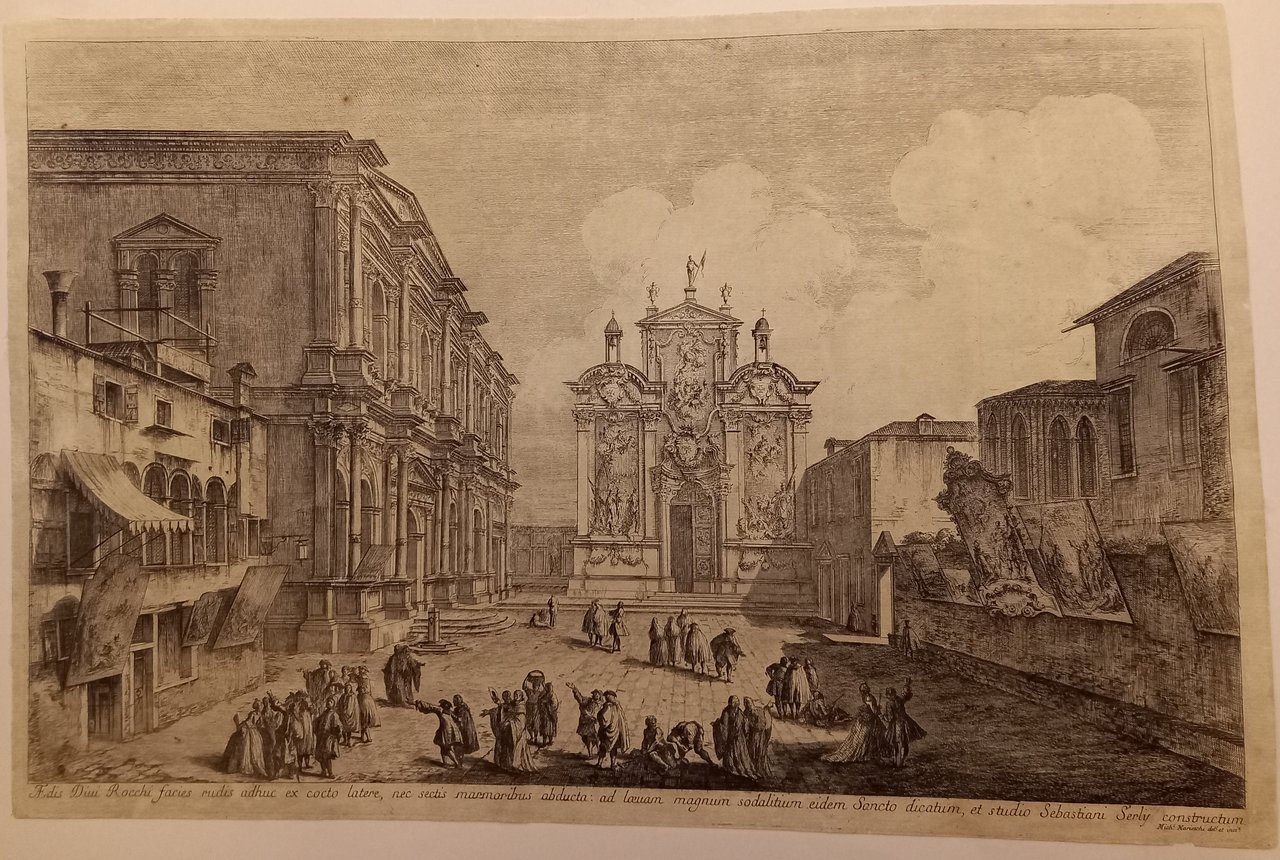Détails
Éditeur
Venezia: Michele Marieschi, 1741
Graveurs
Marieschi Michele
Description
Acquaforte di mm 297 x 467. Vergata grossa. Filigrana non rilevata. Titolo centrato sul margine inferiore, "Mich. Marieschi del.t et inci.t" sull'angolo destro del cartiglio. Primo stato, unico coevo. Provenienza: "Magnificentiores selectioresque urbis Venetiarum prospectus, quos olim Michael Marieschi venetus pictor, et architectus in plerisque tabulis depinxit". "Vendutur in vico Sancti Lucae apud eundem Auctorem Venetijs" 1741 (ma 1742).Brevi margini. Riporta Dario Succi nel catalogo della Mostra tenutasi a Bergamo dal titolo "Marieschi Venezia in scena": "L'acquaforte rappresenta il campo di S. Rocco nel giorno della relativa festività (16 Agosto): in tale ricorrenza fin XVII secolo veniva allestita una mostra di opere d'arte all'aperto, appendendo sugli edifici circostanti dipinti di autori antichi e contemporanei. La proposta di Marieschi per la facciata della chiesa di S. Rocco, all'epoca in fase di ristrutturazione, appare molto estrosa e in linea con lo spiccato gusto scenografico dell'artista. I lavori per la facciata definitiva della chiesa si protrassero dal 1765 al 1769 sotto la direzione di Bernardino Maccaruzzi, il cui progetto è appunto visibile nel terzo stato della stampa". In questo foglio la facciata appare perciò come Marieschi pensava erroneamente sarebbe stata realizzata. Michele Marieschi (1710 - 1743) figlio di un mediocre pittore, studiò con passione architettura e si staccò presto dal padre. Tornato in patria dalla Germania nel 1735, dipinse belle vedute di Venezia. Nel 1741 (o 1742) diede alle stampe la raccolta di 21 acquaforti tratte dalle sue tele. Le incisioni di Marieschi rendono meglio delle sue pitture quel mondo scenografico e teatrale che la Venezia quotidiana offriva all'occhio dell'osservatore. Succi 1987, 10 I/IV, Montecuccoli degli Erri, Pedrocco 1999, 16 I/IV, Mary Pittaluga 1952, pag.35 e seg. Etching of 297 x 467 mm. Large stripe. Watermark not detected. Title centered on the lower margin, "Mich. Marieschi del.t et inci.t" on the right corner of the cartouche. First state, only coeval. Provenance: "Magnificentiores selectioresque urbis Venetiarum prospectus, quos olim Michael Marieschi venetus pictor, et architectus in plerisque tabulis depinxit" . "Vendutur in vico Sancti Lucae apud eundem Auctorem Venetijs" 1741 (but 1742). Short margins. Dario Succi reports in the catalog of the exhibition held in Bergamo entitled "Marieschi Venezia on stage": "The etching represents the Campo di S. Rocco on the day of the relative festivity (August 16): in this recurrence since the seventeenth century an exhibition was set up of works of art outdoors, hanging paintings by ancient and contemporary authors on the surrounding buildings. Marieschi's proposal for the facade of the church of S. the artist's strong scenographic taste. The works for the final facade of the church lasted from 1765 to 1769 under the direction of Bernardino Maccaruzzi, whose project is precisely visible in the third state of the press ". In this sheet the facade therefore appears as Marieschi mistakenly thought it would be built. Michele Marieschi (1710 - 1743) son of a mediocre painter, he studied architecture with passion and soon broke away from his father. Returning to his homeland from Germany in 1735, he painted beautiful views of Venice. In 1741 (or 1742) he published the collection of 21 etchings taken from his canvases. Marieschi's engravings make the scenographic and theatrical world that daily Venice offered to the observer's eye better than his paintings. Succi 1987, 10 I / IV, Montecuccoli degli Erri, Pedrocco 1999, 16 I / IV, Mary Pittaluga 1952, page 35 et seq.

Découvrez comment utiliser
Découvrez comment utiliser

